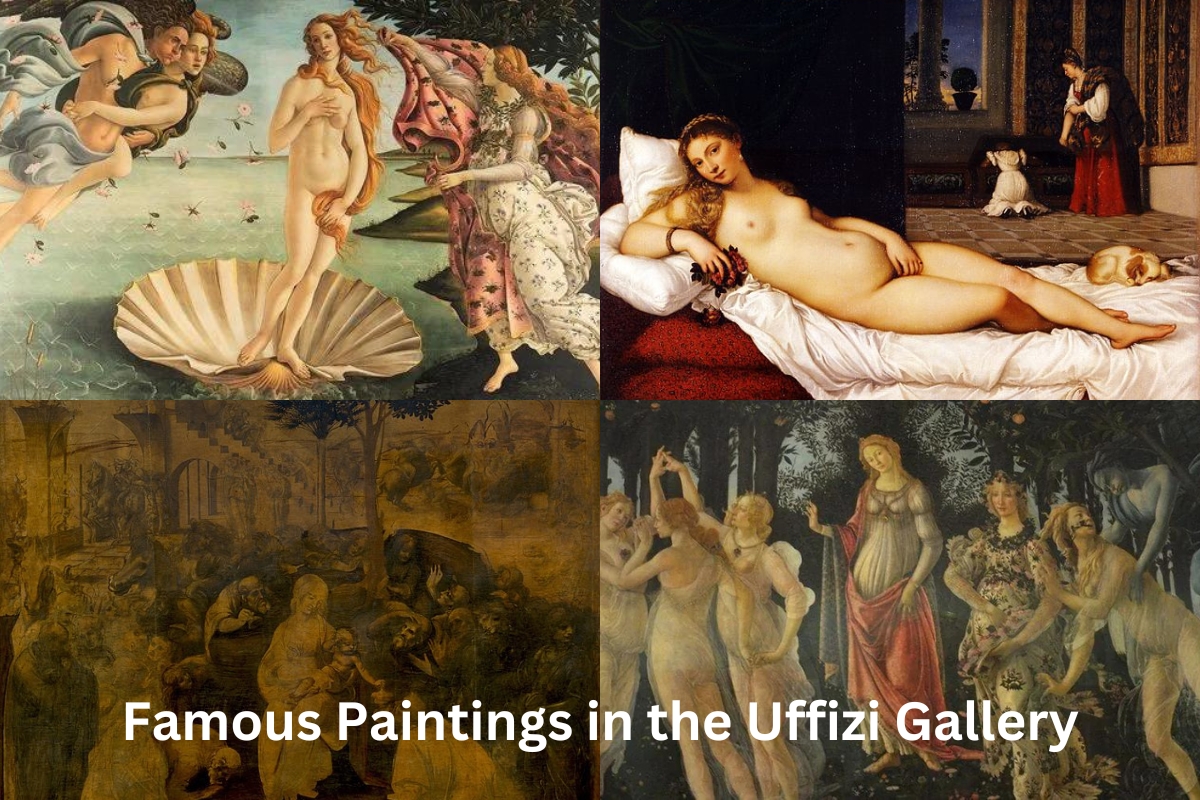The Uffizi Gallery is a renowned art museum that can be found in the Tuscan region of Italy in the Historic Center of Florence, close to the Piazza della Signoria.
It is not only one of the most famous and well-known museums in the world, but also one of the largest and most important museums in all of Italy. It is home to a collection of priceless works, many of which date back to the Renaissance period in Italian history.
In accordance with the well-known Patto di famiglia, which was negotiated by Anna Maria Luisa, the last Medici heiress, the art collections of the governing House of Medici were bequeathed to the city of Florence once the House of Medici passed away.
It is one of the earliest examples of a modern museum. Since the sixteenth century, visitors to the gallery had to make an appointment in order to view the exhibits.
In 1765, the gallery was officially opened to the public, and it was designated as a museum in 1865.
Below are some of the most famous paintings on display at the Uffizi Gallery.
Famous Paintings in the Uffizi Gallery
1. The Birth of Venus – Sandro Botticelli
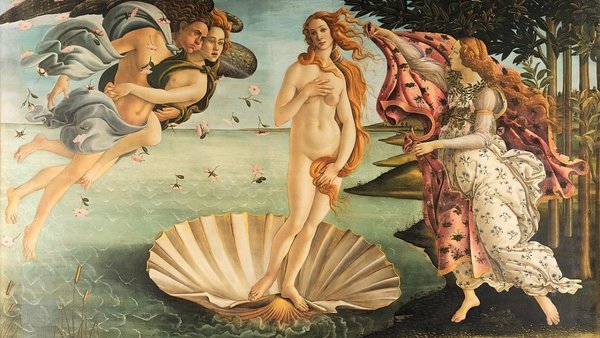
The Birth of Venus, by Botticelli, depicts the Roman goddess Venus being carried ashore on a huge shell, and is often considered to be the finest artwork to emerge from the Renaissance.
The Primavera, another well-known work of Renaissance art by Sandro Botticelli, too has an iconic, mythological connotation.
Also Read: Famous Paintings in Florence
These two masterpieces were commissioned by the Medici, a powerful banking dynasty in Renaissance Florence.
In contrast to the majority of paintings of the time, The Birth of Venus was painted using tempura on canvas.
As opposed to wood, canvas does not warp when exposed to damp, making it a superior material.
2. Primavera – Sandro Botticelli
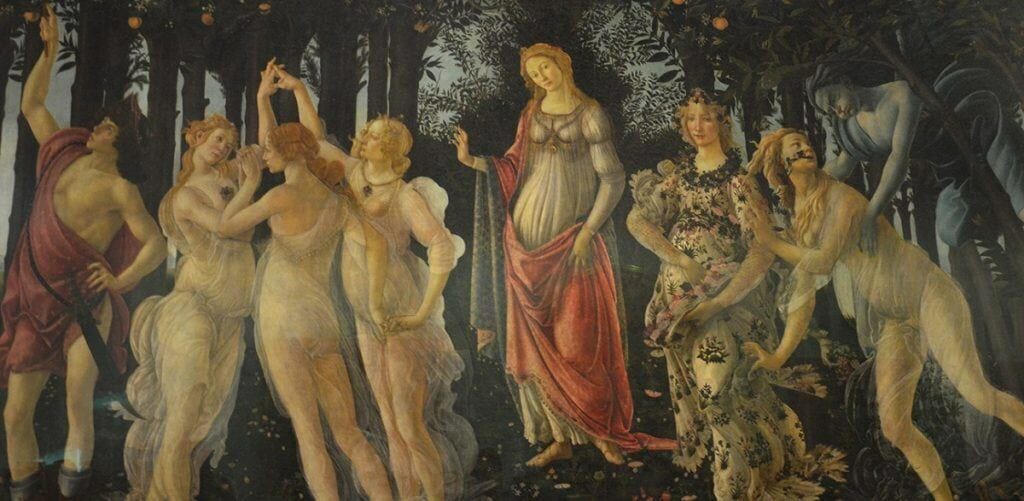
It is thought that Sandro Botticelli created the piece of art that is usually referred to as “Allegory of Spring” in the year 1482 under the title Primavera, which translates to “Spring” in English.
This piece of artwork has been popularly known as “Allegory of Spring.” This is the name that has been given to the piece of art.
Also Read: Famous Paintings in Italy
The question of whether or not the piece of artwork depicts the changing of the seasons or whether it is making reference to a mythical event has been the subject of much discussion among art historians and critics.
Not just because of its significance, but also because of the bold use of color that Botticelli deployed at the time, this piece of artwork is widely considered to be among the best examples of Renaissance painting. This is not only because of its relevance, but also because of the bold use of color.
3. Medusa – Caravaggio

The first version of Medusa was painted by Caravaggio in 1596, while the second was painted by him the following year in 1597. Both versions show the exact moment that Perseus kills Medusa.
Between the years 1571 and 1610, Caravaggio was productive as an artist. He makes light of the concept by substituting his own visage for that of Medusa, which is intended to convey the message that he is unaffected by the impact of her terrifying gaze.
It is stated that the peculiar and elaborate style of the artwork was meant to complement Caravaggio’s specific preoccupation with the gravity of the subject matter and the truth of the situation.
It was commissioned by the Italian ambassador Francesco Maria del Monte in order to send it as a gift to the Grand Duke of Tuscany, and it is today housed in the Uffizi Museum in Florence without having any autographs added to it. The Grand Duke of Tuscany had it given to him as a gift.
Caravaggio drew his subject matter from the myth of Medusa, which served as an inspiration for him. The picture shows Medusa’s severed head, which is a common representation of the monster.
Medusa is generally depicted as a girl with bronze hands and golden wings who wore a head full of deadly snakes in place of her own hair.
According to some retellings of the narrative, Medusa was also said to have possessed golden hands. Everyone who gazed at her for for a second was rendered utterly motionless by the sight of her.
In Greek mythology, gorgons were feared and powerful monsters that appeared in the myths of ancient Greece. Gorgons were a collective name for Medusa and her two sisters, Stheno and Euryale. Medusa was the most famous of the Gorgons.
She was afflicted with a curse from Athena, and as a consequence, she was transformed into the poisonous beast that she was. Perseus, who was the son of Zeus and princess Danae, was the one who ended Medusa’s evil reign. Athena had given Perseus a shield to employ in battle, and he made advantage of it.
Caravaggio replaced the face of the monster in his painting with a self-portrait of his own face so that he could demonstrate that he was unfazed by Medusa’s threatening look. This was done so that the viewer could see that Caravaggio was unfazed.
Despite the fact that its head has been severed, the creature seems to be aware of its surroundings, despite the fact that the artwork depicts it as being motionless in the final moments before it is extinguished.
The jaw is hanging open to its fullest extent, revealing the teeth, and blood can be seen flowing down in several streaks. It is possible to create a terrifying effect by creasing the brows and giving the impression that the eyes are larger.
4. Annunciation – Andrea del Verrocchio and Leonardo da Vinci
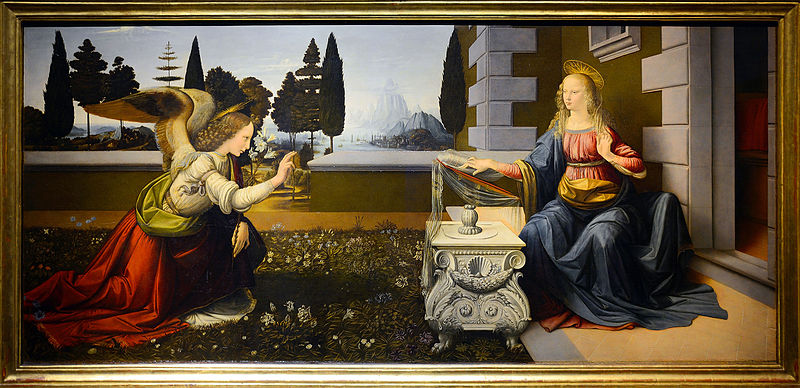
Oil and tempura were applied to wood to make the piece of artwork known as “Annunciation,” and it was produced between the years 1472 and 1475. The Uffizi gallery in Florence, which is located in Italy, is the place to go to see it.
It is possible that Leonardo finished painting the Annunciation when he was in his early twenties while he was still employed in the workshop of Andrea del Verrocchio, for whom he had served as an apprentice when he was younger. Andrea del Verrocchio was a well-known painter who was active in Florence at the time.
Also Read: Famous Art in Italy
The paintings of Leonardo da Vinci are well-known for the intriguing manner in which they depict events from the Bible. This is one of the artist’s many claims to fame. The painting known as “The Annunciation” contains a significant amount of hidden symbolism as well as significance throughout its entirety.
The piece of artwork has a wealth of information, all of which contributes to the narrative of the events that served as its inspiration. For example, this artwork contains a lot of symmetry, balance, and celestial energies, all of which reflect holiness and divinity.
These are qualities that are associated with angels who visited Mary. In addition, this picture features a good deal of symmetry, balance, and the presence of divine forces.
The image has many similarities to other Leonardesque works, such as “Virgin of the Rocks” and “Saint John the Baptist,” amongst others. These similarities were intentionally created by the artist.
5. Doni Tondo – Michelangelo
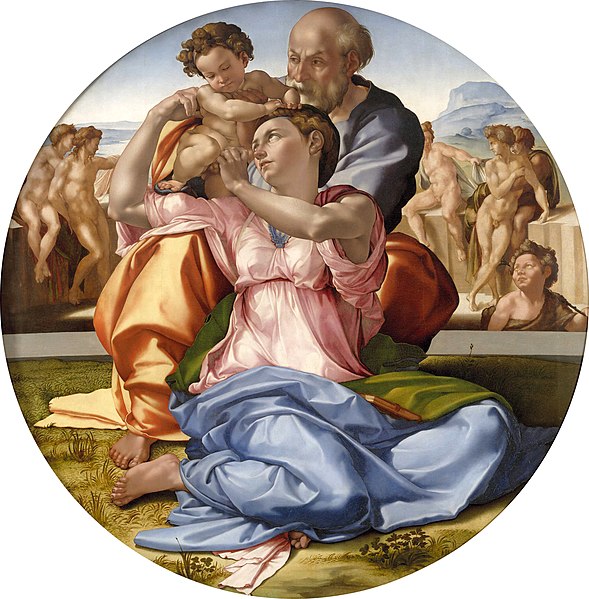
The Doni Tondo was most likely commissioned by Agnolo Doni in order to remember the event of his marriage to Maddalena Strozzi, who came from a famous family in Tuscany. This was most likely done in order to celebrate the occasion of his marriage.
The piece of circular art is in the shape of a tondo, which gets its name from the Italian word for “round.” During the Renaissance period, subjects that were related to the household were widely depicted in tondos.
It is possible to trace the origins of the Doni Tondo back to the time when Michelangelo returned to Florence from his first trip to Rome. This was around the time that the Doni Tondo was created.
This occurred at the same time that the well-known artist of the Renaissance was working on the famous statue of David at the same time.
It is widely regarded as one of the finest examples of late Renaissance Italian art, and it is the only work by Michelangelo that can be located in Florence.
6. Venus of Urbino – Titian
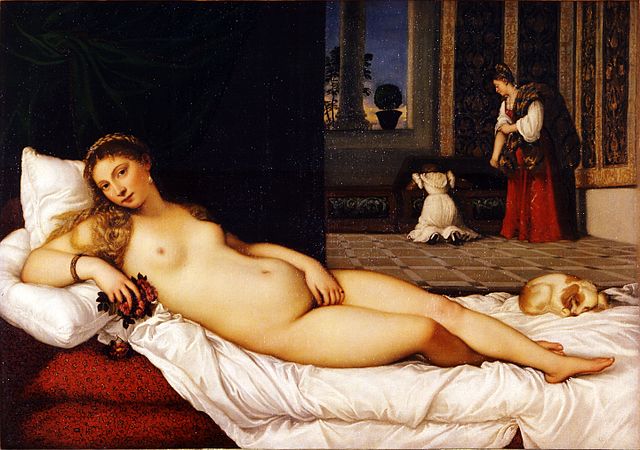
A work done in oil that is frequently referred to as Reclining Venus or Venus of Urbino. It is possible that work on the Venus of Urbino began in 1532 or 1534, that it was finished in 1534, and that it was sold in 1538.
It depicts a young woman, who is commonly identified as Venus, nudistically lying on a sumptuous sofa or bed that dates back to the Renaissance era. It is currently on display in the Gallery of the Uffizi, which is located in Florence.
Giorgione’s Venus of Dresden served as inspiration for the stance, while Titian finished the background for the painting.
In this painting, Titian has domesticated Venus by showing her in a setting that is more personal, by having her interact with the viewer, and by emphasizing the seduction of her feminine beauty.
7. Adoration of the Magi – Leonardo da Vinci
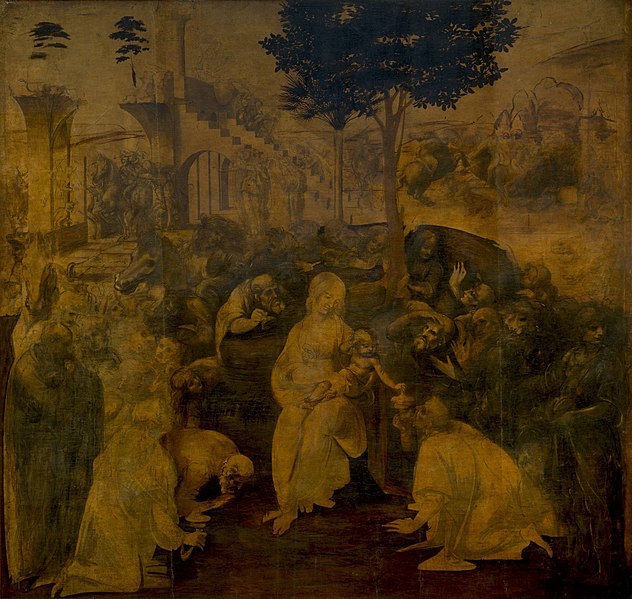
The Adoration of the Magi is an unfinished piece of Leonardo da Vinci’s early Renaissance period.
Leonardo was commissioned to undertake this work in 1481 by the Augustinian monks of Florence’s San Donato in Scopeto, but he moved on to Milan the next year. It has been on display in the Uffizi Gallery in Florence from the year 1670.
When Leonardo died in 1482, the painting was still unfinished, thus the commission went to Filippino Lippi, who completed a second Adoration of the Magi in 1496. It’s also on view at the Uffizi Gallery.
Domenico Ghirlandaio completed a picture in 1488 that expanded on Leonardo’s concept.
The Uffizi Gallery’s six-year restoration project is now complete. The varnish and dirt that had built up over the years were removed with great care.
Incredibly lifelike, the finished object shows every nuance of Leonardo’s charcoal outline and marks. The wood panels have also been restored, ensuring that the work will last for years to come.
8. Bacchus – Caravaggio
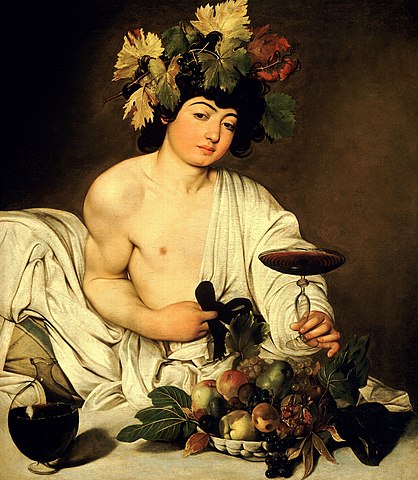
Bacchus is an oil work that was commissioned by Cardinal Del Monte in the year 1596. In the piece of art, a younger version of Bacchus can be seen reclining in a classical manner while wearing grapes and vine leaves in his hair and toying with the drawstring of his robe while it is carelessly hanging.
On the stone table that he sits at, there is a bowl of fruit and a giant carafe of crimson wine waiting for him. He holds out a little cup of the same wine to the audience and urges them to join him in drinking it. At the present time, the piece of art can be seen hanging in the Uffizi Gallery in Florence.
Bacchus was painted not long after Caravaggio entered the home of Cardinal Del Monte, and it is a representation of the educated circle’s humanist concerns that the Cardinal was a part of.
Caravaggio moved at the Palazzo Madama in 1596 and remained there as a guest of a cardinal for the subsequent five years. Del Monte was an avid art collector who commissioned a number of pieces by Caravaggio, one of which was titled “Medusa.”
The cardinal was an avid follower of classic Greek mythology and frequently used allegorical symbols to illustrate his enthusiasm for art, music, and theater. Bacchus and Medusa are two ancient statues that have remained in Florence ever since they were presented as gifts to the Medici family by the cardinal.
Caravaggio’s early success can be attributed, in part, to the support and instruction he received from Del Monte, who is now considered one of the artist’s most prominent sponsors.
9. Diptych of Federico da Montefeltro and Battista Sforza – Federico da Montefeltro and Piero della Francesca
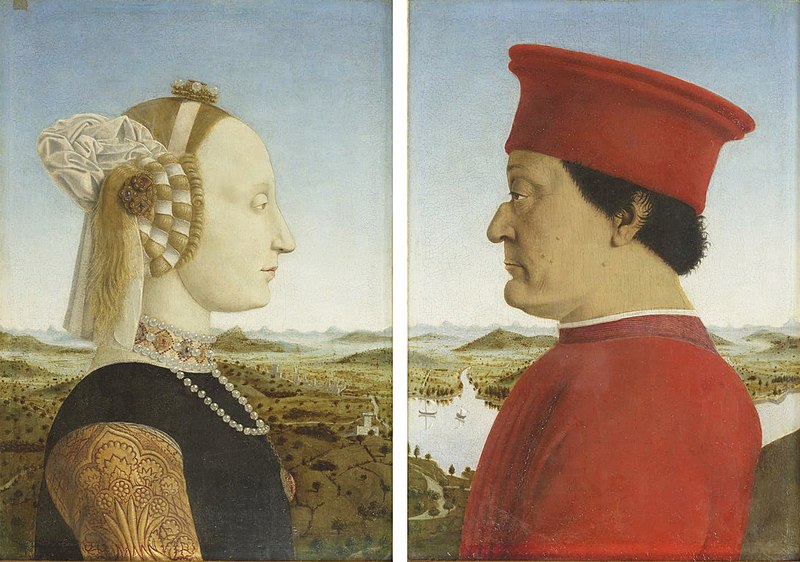
The Diptych of Federico da Montefeltro and Battista Sforza is a painting by Piero della Francesca, created around 1465-1470. It is housed in the Uffizi Gallery in Florence, Italy.
The diptych consists of two panels, each featuring a portrait of one of the two figures mentioned in the title: Federico da Montefeltro, Duke of Urbino, and his wife Battista Sforza.
Federico da Montefeltro is depicted in the right panel, wearing a red and gold gown and a distinctive red and white hat. His posture is upright and confident, and he looks directly at the viewer with a slight smile on his face.
Battista Sforza is depicted in the left panel, wearing a sumptuous blue and gold gown and a headdress adorned with pearls. Like her husband, she looks directly at the viewer, but her expression is more reserved and dignified.
Both portraits are highly lifelike and show a great attention to detail. The realism of the portraits is further enhanced by the use of linear perspective, which creates a sense of depth and three-dimensionality.
10. Ognissanti Madonna – Giotto
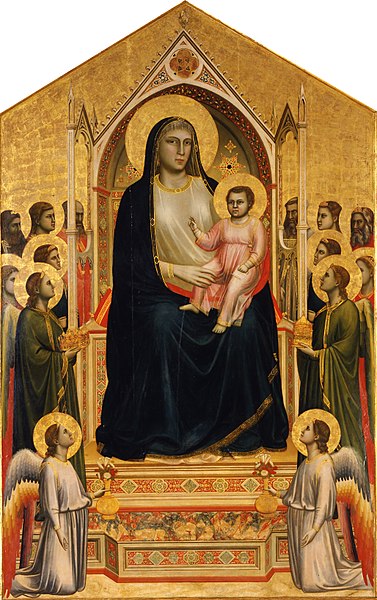
The Madonna Enthroned, or Madonna Ognissanti, is a painting by the Italian late-medievalist Giotto de Bondone that is currently on display in the Uffizi Gallery in Florence, Italy.
The picture depicts a classic Christian scene: the Virgin Mary holding the infant Jesus, with angels and saints gathered around them.
A Maestà is a popular term for this type of depiction of the Virgin Mary from the period. Since it was the first work of art to break free from the strict conventions of Gothic style, it is widely regarded as the birth of the Renaissance.
11. Santa Trinita Maestà – Cimabue
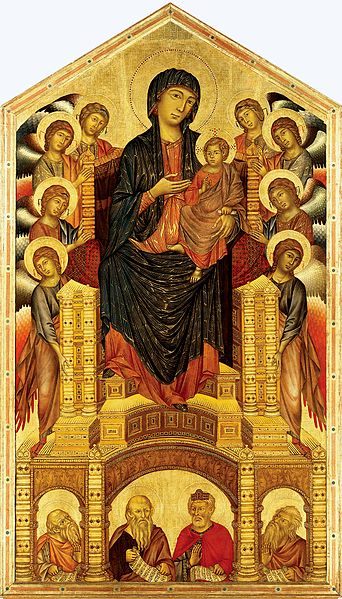
Cimabue, an Italian medieval painter, completed the Santa Trinita Maestà about the year 1300.
The painting was commissioned for and displayed at Santa Trinita Church in Florence until 1471; it is now kept at the Uffizi Gallery in the same city.
There are eight angels encircling the throne, and four prophets’ halves are depicted at the base.
12. Self-portrait – Raphael
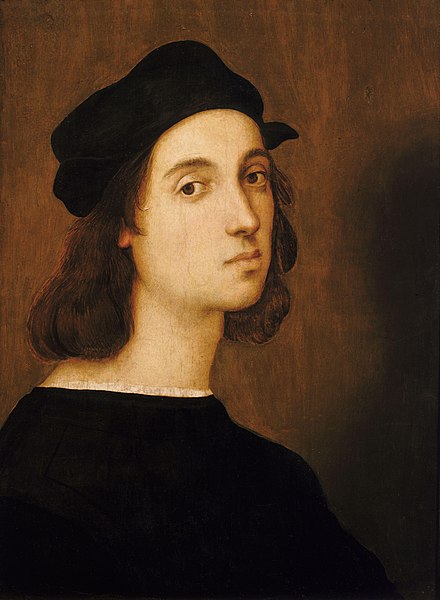
It is generally agreed that the Self-portrait by Raphael was painted between 1504 and 1506.
The image was first recorded in 1675 in an inventory of Duke Leopoldo de’ Medici’s personal collection and then again in 1890 in an inventory of the Uffizi.
Other than that very little is known about the work, but it does at least give us some clue as to Raphael’s appearance.
13. Madonna del Cardellino – Raphael
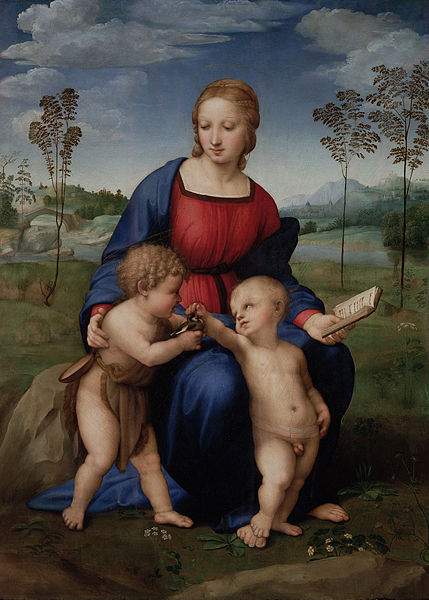
Raphael painted the Madonna del Cardellino, or Madonna of the Goldfinch, between 1505 and 1506. The painting was oil on wood.
The picture was returned to the Uffizi Gallery in Florence in 2008 after a ten-year repair. The gallery displayed an earlier painting while refurbishing it.
Raphael gave his friend Lorenzo Nasi the Madonna for their wedding. On November 17, 1548, an earthquake destroyed Nasi’s house, shattering the picture into seventeen pieces.
Despite its visible seams, it was readily removed and rescued. During the six-year process that began in 2002, a group of volunteers removed years of filth that had faded the painting’s color and repaired seismic damage.
Using X-rays, CAT scans, reflected infrared photography, and lasers, they analyzed the past work before starting.
The restorers methodically eliminated each layer of hasty modifications until Raphael’s original work was revealed. After restoration, the Uffizi Gallery displayed the painting in 2008.

